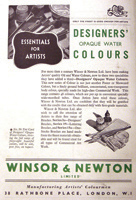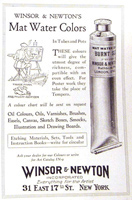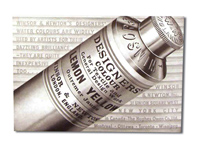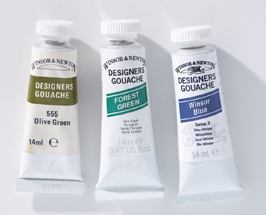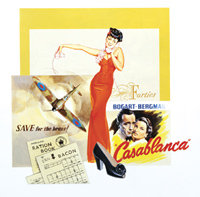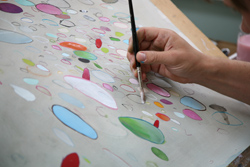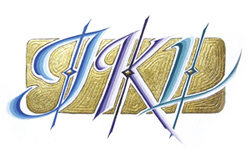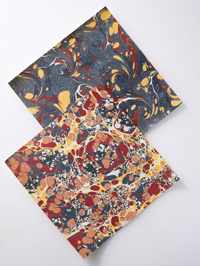£5 OFF Orders over £50 | Use Code 585C
Gouache
What is Gouache?
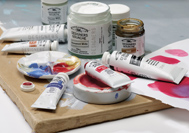 While traditional watercolours are transparent, gouache is a more opaque form of paint. This is an important difference. Gouache paint is like watercolour paint in that gum Arabic is used as the binder and pigments provides the colour. Whereas, the white of the paper provides the light for watercolours, the brilliance of gouache comes from white pigment which is added to the paint to make it opaque. Larger percentages of binder are used than with watercolour and various amounts of inert pigments such as chalk are added to enhance the opacity.
While traditional watercolours are transparent, gouache is a more opaque form of paint. This is an important difference. Gouache paint is like watercolour paint in that gum Arabic is used as the binder and pigments provides the colour. Whereas, the white of the paper provides the light for watercolours, the brilliance of gouache comes from white pigment which is added to the paint to make it opaque. Larger percentages of binder are used than with watercolour and various amounts of inert pigments such as chalk are added to enhance the opacity.
Traditional watercolours are usually applied thinly and the white of the paper shines through the paint to produce the colour. The watercolour artist paints layers of thin watercolour to build up deeper colours or darker values. In a traditional transparent (aquarelle) watercolour, the artist saves plain areas of white paper for white or highlights.
Gouache however, forms a thick layer of paint on the paper surface and does not allow the paper to show through. Gouache is often used by illustrators because it has such a smooth surface that it reproduces well. It is also often used to create highlights in watercolours.
Because many commercial works only have to last until they are photographed the artists are not concerned about permanence of the paint. Some unique colours were created that have a very low permanence. On Winsor & Newton paints AA means very permanent, B a little less permanent etc. Always check the permanence of the tubes you buy.
The History of Gouache
Gouache is actually both a technique and a product.
The technique, dating to before the Renaissance, refers to the use of white to achieve opacity in water based colours. Originally used for illuminating manuscripts, it was Paul Sandby in the 18th century who first used the painting technique extensively and later the Pre-Raphaelites. Opaque techniques were further popularised by the Impressionists and Post-Impressionists, in their use of pastel, lithography and wood cuts.
Gouache, the product, was a result of this interest in both opaque and water based products. Poster colour appeared after the First World War and this was significantly improved upon by Winsor & Newton, with the introduction of Designers Opaque Water Colour in the 1930's.
|
|
|
|
Why Use Gouache?
Gouache is a very versatile paint which can transcend the boundaries of many mediums. It can make a wash like a water colour, blend like an oil colour and dry brush like acrylic.
It can be used thinly for a wash at the start of a painting then applied in thicker layers towards the end. Due to its opaque nature it can be applied in solid colours, allowing you to paint in layers from dark to light.
It is a direct and quick drying paint with superb covering power which is achieved by the high levels of pigmentation (not by the use of fillers or opacifies). Unlike transparent water colour, where you need to plan and reserve the white of the paper, gouache is more controllable and enables you to remove mistakes and re-paint.
Who Uses Gouache?
| |
Fine artists - use it in conjunction with water colour or on its own as opaque water colour. Its brilliance and opacity give it solidity, excellent for abstract work and extra details. Strong effects also result from the contrast of working on colour backgrounds which are left partly exposed. | |
Calligraphers - gouache is used by calligraphers because of its excellent flow, opacity and permanence. | |
Marblers - the high pigmentation and gum Arabic base make it a common choice with professional marblers. |
How to Use Gouache
Whether you work in watercolour and would like to add an extra dimension to your technique or you are an oil painter who would like an opaque to paint with that is quick drying and easy to transport with no need for solvents or oils – Gouache paint could be just what you need.
Gouache is designed to be used more thickly than traditional watercolours. The paint should be applied in a solid film of colour for a gouache painting technique. Be careful though, if you apply the paint too thick, the resulting painting may crack off, especially if the colours have a high percentage of chalk. The colours can be thinned with water and made to soak into the paper, but this technique is most often used for underpainting.
When painting, the light tints are made with a mixture of white and colour and the whites are applied paint instead of the white of the paper. Gouache paintings are often done on a toned (coloured) paper or board so that the base colour unifies the painting.
Artists choose to paint with gouache when they want to make paintings with solid areas of colour or to paint elements one on top of the other.
Benefits of Gouache
* Gouache has a thick consistency and is more opaque than other paints it is perfect for laying large areas of flat colour.
* It is excellent for creating rich deep tones in paintings.
* Gouache enables you to paint light colours over dark ones without any hint of the underlying colour showing through.
* It can be thinned down with water to give it a translucency which is comparable to pure watercolour and can be used in the same way.
* The variety of surfaces available to paint on with Gouache are significantly more than those available when painting with watercolour.
* Unlike transparent watercolours, where a mistake can be a problem, gouache allows the artist to change the work and completely cover a difficult area.
Winsor & Newton Designers Gouache
Designers Gouache colours are a range of opaque water colours, so called because they were developed for and continue to be mainly used by designers. Gouache is however also used by fine artists as an opaque water colour , or in combination with Artists’ Water Colour.
Winsor & Newton Designers Gouache is accepted today as the finest quality range available, with a wide colour spectrum catering for both designers and fine artists. In addition unsurpassed covering power is achieved by the high level of pigmentation and brilliance of colour from the use of pure pigments. In use, the colours’ even flow produces flat washes without streaking.
The colours carry the same permanence ratings as other Winsor & Newton artists’ quality ranges. AA and A rated colours are recommended as permanent for fine artists.
All Designers Gouache colours are fully compatible with Winsor & Newton water colour products. Colours may also be mixed with Professional Acrylic and Galeria Flow Formula Acrylic, however care should be taken as some gouache colours can adversely react with acrylics.
The pinks and violets in Designers Gouache can have a tendency to change colour on combination with acrylic. Some other Designers Gouache colours may be sensitive to alkali and produce gelatinous or lumpy mixtures. Combinations should be tested on the palette prior to their use in painting.
For fine art painting, water colour papers are recommended to exploit the widest variety of techniques and ensure long term stability. Designers tend to use illustration board or hot pressed water colour paper for a flat finish which reproduces well.
Colour Range
The range of colours have been chosen according to mass tone (colour from tube), colour bias (undertone), colour strength and relative opacity. The range includes bright colours for designers and more lightfast ones for fine artists. The resultant colour range ensures that all artists can obtain the palette which suits their work. All colours can be safely intermixed.
Sizes available
Designers Gouache has recently benefited from a wide ranging review in our research & development laboratory and now offers a wide range of 85 colours.
All colours are available in 14ml tubes (except Bleed proof White, Process White and Photographic Opaque); a selected number of whites, blacks and metallics are available in 30ml, 60ml, and 100ml pots and 37ml tubes. A selection of boxed sets are also available.
Raw materials
Choosing the raw materials for the Designer Gouache range of colours requires years of knowledge and expertise from our chemists. We select materials from thousands of sources across the globe to ensure that we have the highest quality to make the most superior formulations. Once accepted as a Winsor & Newton ingredient each raw material is subjected to scrupulous quality control checks at the time of delivery to ensure they meet with our high standards before the manufacturing process can begin.
Formulation
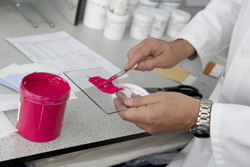 Good quality gouache colour is a combination of pigment and gum Arabic. Gum Arabic is the binder that holds the pigment, giving it that perfect creamy 'flowing' consistency. (NB some cheaper brands may have chalk added to the pigment which in turn effects the 'flow and the brilliance of colour').
Good quality gouache colour is a combination of pigment and gum Arabic. Gum Arabic is the binder that holds the pigment, giving it that perfect creamy 'flowing' consistency. (NB some cheaper brands may have chalk added to the pigment which in turn effects the 'flow and the brilliance of colour').
Every colour within the range has an individual formulation to take advantage of each and every pigment characteristic and ensure tube stability.
We call upon the expertise of our chemists who have many years of experience to develop formulations using the excellent raw materials sourced, we utilise our state of the art manufacturing techniques to deliver colour that is the best available – our Designers Gouache colours are more commonly chosen than any other gouache range.
Pigments
Pigments are sourced from many different places, some are natural products - notably the earths (umbers, Ochre’s etc); some are from metal compounds and are often referred to as ‘traditional’ or ‘genuine’ (cadmiums, cobalt’s, titanium) and there is an ever growing range of organic pigments available as a result of the distillation of petroleum, these are often termed ‘modern’. In total there are 45 different pigments used in the Designers Gouache range.
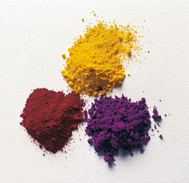 Within the Designers Gouache range there are many single pigment colours in order to provide the widest handling properties and maintain clean mixing. We always try to use single pigments wherever possible as they are purer in hue and cleaner in colour than mixtures of pigments. This provides a larger number of colour mixes before resulting in muddy colours. This is of most interest to the fine artists.
Within the Designers Gouache range there are many single pigment colours in order to provide the widest handling properties and maintain clean mixing. We always try to use single pigments wherever possible as they are purer in hue and cleaner in colour than mixtures of pigments. This provides a larger number of colour mixes before resulting in muddy colours. This is of most interest to the fine artists.
In addition to the single pigment colours there are the other colours that are produced using specific mixtures of pigments. These are equally important as we understand that it is difficult if not impossible to consistently mix some colours by hand and time consuming if you are doing so when painting. By Winsor & Newton mixing these colours in the manufacturing process the artist is saving time and colour otherwise wasted on incorrect mixing. As an opaque medium it is also more difficult to obtain a complete spectrum with single pigments because many are naturally more transparent. We therefore provide these mixed colours to ensure the widest spectrum without compromising brilliance and opacity.
Pigment Strength
It is widely misunderstood that Gouache is opaque as a result of adding chalk or other such materials. The opaque colours within the Winsor & Newton Designers Gouache range are opaque due to the exceptionally high levels of pigmentation in the formulation, which results in unsurpassed covering power and clean colour mixing. A number of colours now have increased pigment strength.
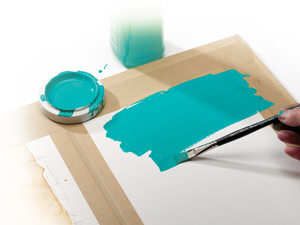
Spectrum/Colour Range
One of the main reasons artists choose Winsor & Newton is our colour spectrum. The Designers Gouache range offers a wide and balanced spectrum of 82 tube colours (4 additional colours in pots). These colours have been chosen according to mass tone (colour from tube), colour bias (undertone), colour strength and relative opacity. The range includes bright colours for designers and more lightfast ones for fine artists. The resultant colour range ensures that all artists can obtain the palette which best suits their work, and also that all colours can be safely intermixed.
As a result of the recent review there are now also a number of unique ultra bright colours such as Opera Pink and Opera Rose.
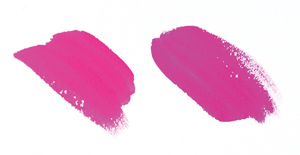
Opacity
All the Designers Gouache colours are more opaque than Artists' Water Colours. However, the degree to which they cover does vary. The relative opacity of the colours is marked on the colour chart; the transparent colours are marked with  or T and the opaque colours are marked with
or T and the opaque colours are marked with  or O. When overpainting in layers, the relative ‘staining' (bleeding) properties of the colours are indicated on the colour chart.
or O. When overpainting in layers, the relative ‘staining' (bleeding) properties of the colours are indicated on the colour chart.

Bleeding/Staining Colours
When overpainting in layers, the relative ‘staining' (bleeding) properties of the colours are also indicated on the colour chart.
Series
Due to the wide range of pigments used in the range it is necessary to use a series system. The series indicates the relative price of the colour and is determined mainly by the cost of the pigment. Designers Gouache has four series with Series 1 being the least expensive and Series 4 the most expensive.
Gouache Properties
Permanence
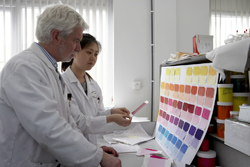 Designers Gouache has the same ratings as the other Winsor & Newton artists' quality ranges. AA and A rated colours are recommended as permanent for fine artists. Some of the brighter, Designers' Gouache colours within the range are only available as B or C rated. This is because in certain areas of the spectrum, particularly magenta, pigments are not available to achieve permanence as well as brightness and opacity.
Designers Gouache has the same ratings as the other Winsor & Newton artists' quality ranges. AA and A rated colours are recommended as permanent for fine artists. Some of the brighter, Designers' Gouache colours within the range are only available as B or C rated. This is because in certain areas of the spectrum, particularly magenta, pigments are not available to achieve permanence as well as brightness and opacity.
As the designer's original art work is unlikely to be required after reproduction, brightness takes priority. However we strive to deliver the best possible lightfastness we can and have recently been able to improve some of our colours to A ratings.
Covering power
The covering power of the Winsor & Newton Designers Gouache colour range is unsurpassed due to its high pigment content. The natural attribute of each of the pigments will also add to the level of opacity which further contributes to covering power.
Brilliance of Colour
The brilliance of colour achieved with the Designers Gouache range is stunning, every colour is bold and vibrant as a result of the meticulous toil that goes in to selecting the pigments, the quality of those pigments and concentration of the pigment in the colour.
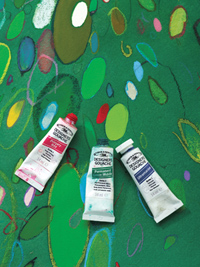
Even Flow
Designers Gouache is renowned for its smooth even flow, it glides across grounds resulting in a flat non streaky finish.
Gouache should not be applied too thickly as it may crack.
Matt Finish
As a result of the high level of pigmentation Winsor & Newton Designers Gouache dries to a matt finish. This reduces the reflection when photographing the work.
Drying Times
One of the natural attributes of gum Arabic - the binder used in Designers Gouache is that it is quick drying. This faster drying allows quick working techniques and preliminary sketching to be done. Also as with water colour, work can be finished quickly and as a result travelling with work is made much easier.
Recommended Colour Palette
Lemon Yellow, Permanent Yellow Deep, Scarlet Lake, Cadmium Red Pale, Alizarin Crimson, Phthalo Blue, Ultramarine, Winsor Green, Burnt Umber, Yellow Ochre, Burnt Sienna, Zinc White.
The Whites
Permanent White is the whitest, most opaque white. It is not recommended for mixing as it can reduce the lightfastness of some colours.
Zinc White produces the cleanest and most lightfast tints and is therefore recommended for colour mixing. Bleedproof White is used by designers to prevent underlayers from bleeding through. This is a temporary solution and is not appropriate for fine art use as bleeding will occur eventually. Laser White is similar in colour and opacity to Permanent White and can be used for colour mixing. Process White is designed for use in photographic retouching, where it will reproduce its true value.
The Blacks
Jet Black is a rich, deep, opaque black which makes blue greys when mixed with white. Lamp Black is a less opaque black of lower tinting strength, giving paler blue (cool) greys when mixed with white. Ivory Black is also less opaque with lower tinting strength and makes brown (warm) greys and sepia tones when mixed with white. Process Black is designed for use in photographic retouching where it will reproduce perfectly black.












